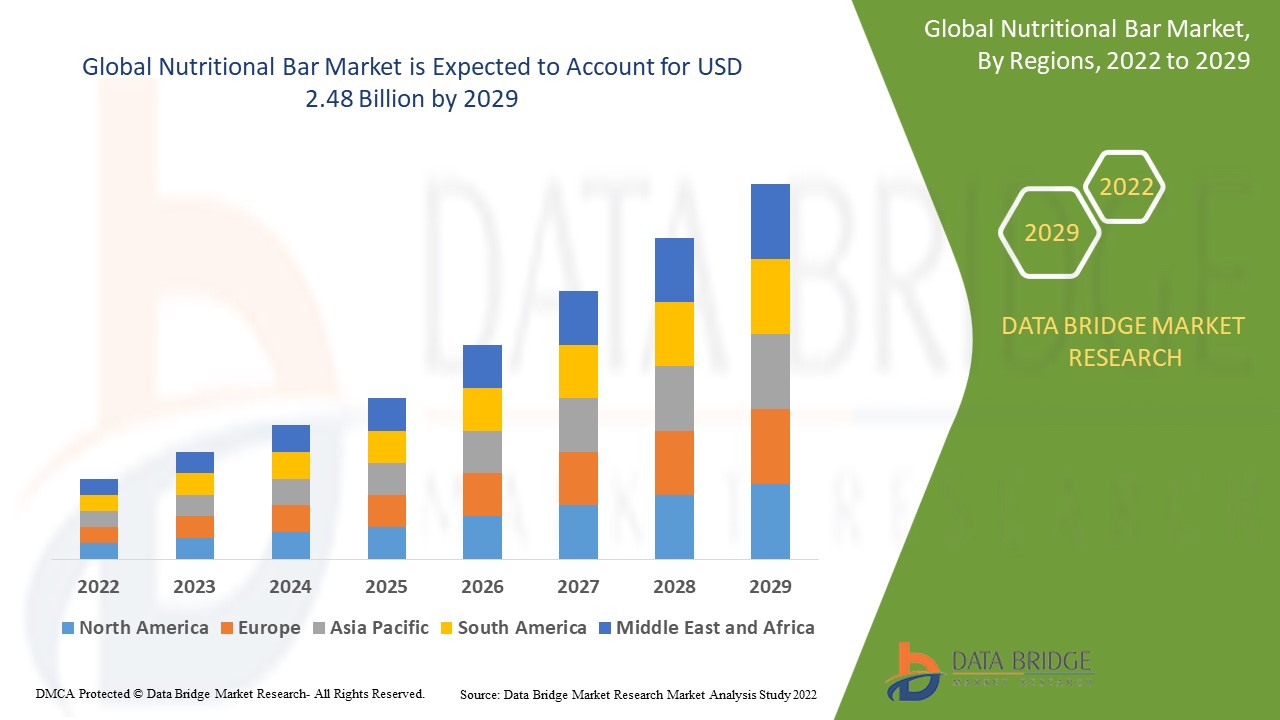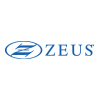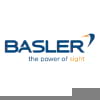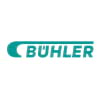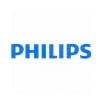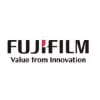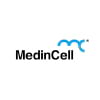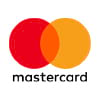Global Nutritional Bar Market By Types (Protein Bars, Meal-Replacement Bars, Snacks Bars, Whole Food Bar and Others), Flavour (Chocolate, Fruits, Peanut Butter, Savoury, Spices and Others), Distribution Channel (Store-Based, Non-Store Based) – Industry Trends and Forecast to 2029
Nutritional Bar Market Analysis and Size
Fitness clubs' marketing campaigns for nutritional bars as a meal replacement substitute have skyrocketed sales of these products. The market is expected to grow during the forecast period due to an increase in the number of health clubs and increasing awareness about nutritional bars.
Data Bridge Market Research analyses that the nutritional bar market was valued at USD 1.30 billion in 2020 and is expected to reach the value of USD 2.48 billion by 2029, at a CAGR of 8.43% during the forecast period of 2022-2029. In addition to the market insights such as market value, growth rate, market segments, geographical coverage, market players, and market scenario, the market report curated by the Data Bridge Market Research team includes in-depth expert analysis, import/export analysis, pricing analysis, production consumption analysis, patent analysis and consumer behaviour.
Report Scope and Nutritional Bar Market Segmentation
|
Report Metric |
Details |
|
Forecast Period |
2022 to 2029 |
|
Base Year |
2021 |
|
Historic Years |
2020 (Customizable to 2014 - 2019) |
|
Quantitative Units |
Revenue in USD Billion, Volumes in Units, Pricing in USD |
|
Segments Covered |
Types (Protein Bars, Meal-Replacement Bars, Snacks Bars, Whole Food Bar and Others), Flavour (Chocolate, Fruits, Peanut Butter, Savoury, Spices and Others), Distribution Channel (Store-Based, Non-Store Based), |
|
Countries Covered |
U.S., Canada and Mexico in North America, Germany, Sweden, Poland, Denmark, France, U.K., Netherlands, Switzerland, Belgium, Russia, Italy, Spain, Turkey, Rest of Europe in Europe, China, Japan, India, South Korea, Singapore, Malaysia, Australia, Thailand, Indonesia, Philippines, Rest of Asia-Pacific (APAC) in the Asia-Pacific (APAC), Saudi Arabia, U.A.E, South Africa, Egypt, Israel, Rest of Middle East and Africa (MEA) as a part of Middle East and Africa (MEA), Brazil, Argentina and Rest of South America as part of South America |
|
Market Players Covered |
Cargill Incorporated (US), ADM (US), Dupont (US), Evonik (Germany), BASF SE(Germany), DSM (Netherlands), Ajinomoto Co., Inc. (Japan), Novozymes (Denmark), Chr. Hansen Holding A/S (Denmark), TEGASA (Spain), Nutreco (Netherlands), Kemin Industries Inc. (US), Adisseo (France), Alltech (US), Global Nutrition International (France), Centafarm SRL (Italy), Bentoli (US), and Novus International (US) |
|
Opportunities |
|
Nutritional Bar Market Definition
Nutritional bars are low in sugar, high in protein, and high in omega-3 fatty acids, with fewer additives. They are considered a healthier alternative to other bars due to their high protein and fibre content. Nutritional bars can help to repair muscle, improve protein levels in the body, improve body performance, boost metabolism, and lower glucose and saturated fat levels before and after a workout.
Nutritional Bar Market Dynamics
Drivers
- The increasing prevalence of chronic diseases around the world and a need of nutrient rich convenient food
The global demand for nutritional bars has been fuelled by the prevalence of hectic consumer lifestyles that result in on-the-go food consumption. Furthermore, rising health concerns among consumers who prefer a well-balanced diet rich in nutrients have increased product demand. Aside from that, an increase in the number of health awareness programmes emphasising the importance of wellness and nutritional diet has influenced global consumption of nutritional bars.
- Benefits of consuming Nutritional Bar as well as growing per capita income
As the global demand for nutrition bars grows, a number of new players have entered the market. While traditional nutrition bars continue to attract new customers, several brands are increasingly focusing on niche preferences, such as gluten-free and plant-based products. Several brands are increasingly focusing on improving the nutritional content of their products by incorporating high-nutritional-content ingredients.
Opportunity
People are more concerned about their health now than they were before the covid-19 pandemic. The government in many countries is encouraging people to eat healthy foods in order to boost their immunity; as a result, the demand for nutritional bars has increased. Aside from that, there are various types and flavours of nutritional bars available, and changing people's taste preferences and government initiatives will provide more opportunities for the nutritional bar market. In addition, the growing number of fitness and wellness centres around the world will drive up demand for nutritional bars.
Restraints
One of the most significant market constraints is the fluctuation of raw material prices for nutritional bars. Aside from that, constantly changing consumer behaviour and preferences toward snack food items and fluctuating product costs are restraining market growth. The presence of local snack makers is also a hindrance to the nutritional bar marker. The market's growth is hindered by the availability of a wide range of substitute products for these bars, such as energy drinks, cookies, and powder.
This nutritional bar market report provides details of new recent developments, trade regulations, import-export analysis, production analysis, value chain optimization, market share, impact of domestic and localized market players, analyses opportunities in terms of emerging revenue pockets, changes in market regulations, strategic market growth analysis, market size, category market growths, application niches and dominance, product approvals, product launches, geographic expansions, technological innovations in the market. To gain more info on the nutritional bar market contact Data Bridge Market Research for an Analyst Brief, our team will help you take an informed market decision to achieve market growth.
COVID-19 Impact on Nutritional Bar Market
During the lockdown due to the COVID-19 pandemic, increased sales of products such as snacks, bars, and other convenience foods were observed, which sustained demand for protein bars in the market studied. The ambiguous situation around the world urged consumers to increase their nutritional intake and consume safer and healthier foods as their interest in products that support the overall maintenance of health and wellness increased. Also, as a result of the work-from-home or stay-at-home trend, people began working out at home, increasing the demand for protein bars.
Recent Developments
- RXBAR will launch a plant-based protein bar in June 2021. The all-new RXBAR protein bar contains 10 grammes of plant-based protein instead of RXBAR's signature egg whites and is available on RXBAR.com and in stores such as Target and Kroger.Q
- Nestle introduced a pea protein bar in 2020 as part of its YES snack bar line. This snack bar has 10g of protein and is made up of nuts and peas. These snacks come in a variety of flavors, including almond, peanut, double dark chocolate, and cashew, blueberry, and dark chocolate.
- Post Holdings Inc expanded the reach of Premier Protein's brand snack bar in convenience stores in the United Kingdom in 2020 in order to increase its market share.
Global Nutritional Bar Market Scope
The nutritional bar market is segmented on the basis of type, distribution channel and flavour. The growth amongst these segments will help you analyze meagre growth segments in the industries and provide the users with a valuable market overview and market insights to help them make strategic decisions for identifying core market applications.
Type
- Protein Bars
- Meal-Replacement Bars
- Snacks Bars
- Whole Food Bar
- Others
Flavours
- Chocolate
- Fruits
- Peanut Butter
- Savoury
- Spices
- Others
Distribution channel
- Store based
- Non-store based
Nutritional Bar Market Regional Analysis/Insights
The nutritional bar market is analysed and market size insights and trends are provided by country, type, distribution channel and flavour as referenced above.
The countries covered in the nutritional bar market report are U.S., Canada and Mexico in North America, Germany, Sweden, Poland, Denmark, France, U.K., Netherlands, Switzerland, Belgium, Russia, Italy, Spain, Turkey, Rest of Europe in Europe, China, Japan, India, South Korea, Singapore, Malaysia, Australia, Thailand, Indonesia, Philippines, Rest of Asia-Pacific (APAC) in the Asia-Pacific (APAC), Saudi Arabia, U.A.E, South Africa, Egypt, Israel, Rest of Middle East and Africa (MEA) as a part of Middle East and Africa (MEA), Brazil, Argentina and Rest of South America as part of South America.
Asia-Pacific dominates the nutritional bar market because of the rapid population growth in the region. The presence of major key players will boost the growth of the regional nutritional bar market during the forecast period. Due to the growing demand for nutritional bars, North America is expected to see significant growth in the nutritional bar market. Furthermore, the region's growing health-conscious population is expected to drive the growth of the nutritional bar market in the coming years.
The country section of the report also provides individual market impacting factors and changes in market regulation that impact the current and future trends of the market. Data points like down-stream and upstream value chain analysis, technical trends and porter's five forces analysis, case studies are some of the pointers used to forecast the market scenario for individual countries. Also, the presence and availability of global brands and their challenges faced due to large or scarce competition from local and domestic brands, impact of domestic tariffs and trade routes are considered while providing forecast analysis of the country data.
Competitive Landscape and Nutritional Bar Market Share Analysis
The nutritional bar market competitive landscape provides details by competitor. Details included are company overview, company financials, revenue generated, market potential, investment in research and development, new market initiatives, global presence, production sites and facilities, production capacities, company strengths and weaknesses, product launch, product width and breadth, application dominance. The above data points provided are only related to the companies' focus related to nutritional bar market.
Some of the major players operating in the nutritional bar market are:
- Cargill Incorporated (US)
- ADM (US)
- Dupont (US)
- Evonik (Germany)
- BASF SE(Germany)
- DSM (Netherlands)
- Ajinomoto Co., Inc. (Japan)
- Novozymes (Denmark)
- Chr. Hansen Holding A/S (Denmark)
- TEGASA (Spain)
- Nutreco (Netherlands)
- Kemin Industries Inc. (US)
- Adisseo (France)
- Alltech (US)
- Global Nutrition International (France)
- Centafarm SRL (Italy)
- Bentoli (US)
- Novus International (US)
SKU-





 Forecast Period
Forecast Period  Market Size (Base Year)
Market Size (Base Year)  Market Size (Forecast Year)
Market Size (Forecast Year) CAGR
CAGR